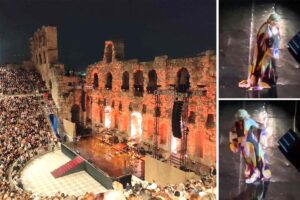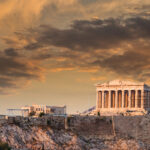Source: greekreporter.com
The destruction of an old Greek Orthodox church in Kokkinomilia was one of the many sad losses Evia has suffered after the fires that ravaged the island.
Villages were evacuated and left to the infernos, hundreds of houses were destroyed, leaving whole families homeless, and hundreds of thousands of acres of forest land were burned.
The Evia fires brought about the largest environmental catastrophe in Greek history, as almost half of the island has been reduced to ashes and the rich green of the land has turned to black.
The tears of the priest of the Agioi Taxiarches church that is completely destroyed tell as much as the pictures of the towering flames that engulfed whole forests and villages.
Because for Father Ioannis Siaflekis, the Evia inferno did not only burn his church and most everything in Kokkinomilia to cinders, but also signified the end of a traditional Evia village.
The story of Father Ioannis and the burning of the Kokkinomilia church is the story of a country that often becomes prey to destructive natural phenomena.
Father Ioannis in the ashes of his church
His voice often cracks. He is fighting to hold his tears. He walks around the ashes and what is left from the fire, seemingly unable to accept the dreadful fact that his church no longer exists.
“This is has been here since 1900, or maybe earlier,” he tells Greek Reporter, still referring to it in the present tense, still incapable of believing what his eyes are telling him.
“The church’s official opening was in 1907. Since then there is a holy liturgy every Sunday. It was only last Sunday (August 8) that there was no liturgy,” he says about the day the flames swallowed the church and spat out ashes.
The churchyard of Agioi Taxiarches in Kokkinomilia, like in every church in a small Greek village, is the center of all social life. It is the heart of the village. It is the place where everyone used to meet. Until that Sunday.
“When I saw the (burnt) church I was so moved that I choked. I lost my voice. I cried so much until I ran out of tears. I almost collapsed,” he says.
“The life of the village was this church. Everything was happening here. Fairs, holy feasts, weddings, baptisms. All this is gone now,” he says, trying, with no success, to hold back his tears.

Going back to that fateful day on Evia and the burning of his church, he still tries to comprehend how all that could be gone. How the firemen could not manage to save his church and the rest of the village from the ravenous blaze.
“The state did not contribute. People did not contribute,” he says, without putting the blame on anyone for the burning of the Evia church and village.
In the middle of the gray and black debris, Father Ioannis tries to gather up some sliver of hope. The hope that some day his Kokkinomilia church will be standing again, gathering all the villagers.
“We have telephone calls, we have donations. Greeks are sensitive and giving. I believe they will help (to rebuild the Kokkinomilia church),” he says.
However, he is not so optimistic about the future of the village itself. Most of its residents are lumberjacks and the fires did not leave any trees to cut after the fires destroyed the Evia village.
“Most of them will leave to work elsewhere and the village will be deserted,” he says.
The history of the village of Kokkinomilia on Evia Island

Kokkinomilia, formerly also known as Kokkinomilea, is the most mountainous village of Northern Evia. It is 16 km (9 miles) away from Istiaia and 90 km (56 miles) from Chalkida and belongs to the municipality of Istiaia – Edipsos.
The altitude of the village is 581 meters (1,906 feet) above sea level and it is one of the oldest and most historic villages of Northern Evia.
Until a few days ago, the village had been surrounded by dense forest and was suitable for mountain hikes, as it is located just 5 km from Drymonas Waterfalls and only 8 km from the Fossil Forest and the Museum of Fossil Mammals of Kerasia.
Kokkinomilia has a long history and there are many legends about its establishment, going back into time immemorial. It dates back to the Paleolithic period, according to findings in the area.

The village seems to have taken its name from the red apple trees that used to be abundant there. A second version speaks of a Turkish commander of the village, whose origin was the Red Apple, a place in Asia Minor.
The first references to Kokkinomilia are from the founding of the Greek State; it is mentioned in one of the letters to Ioannis Kapodistrias penned by Nikolaos Kalogeropoulos and dated September 3, 1830.
Kokkinomilia at that time had 30 families and is also recorded in a list of villages of Greece in 1836.
Some of the families of Kokkinomilia participated in the Greek War of independence. The firs stirrings of the revolution in that area started on May 8, 1821 in Istiaia.
The inhabitants of the village are mainly farmers, stockbreeders, lumberjacks and resin collectors. It was also one of the few villages in the area that still had water-powered mills.










